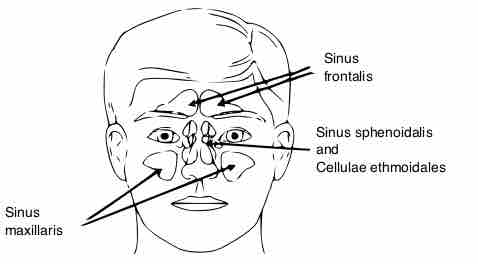Paranasal sinuses are a group of four, paired, air-filled spaces that surround the nasal cavity (maxillary sinuses), above the eyes (frontal sinuses), between the eyes (ethmoid sinuses), and behind the eyes (sphenoid sinuses). The sinuses are named for the facial bones that they are located behind.
- The maxillary sinuses (also called the maxillary antrechea, the largest of the paranasal sinuses) are located under the orbits in the maxillary bones.
- The frontal sinuses are superior to the orbits and are in the frontal bone.
- The ethmoid sinuses are formed from several discrete air cells within the ethmoid bone between the nose and the orbits.
- The sphenoid sinuses are in the sphenoid bone at the center of the skull base under the pituitary gland.
- The paranasal sinuses are lined with respiratory epithelium.

Skull Sinuses
This image shows the position of the sinuses in the human skull.
The paranasal sinuses form developmentally through excavation of bone by air-filled sacs (pneumatic diverticula) from the nasal cavity. This process begins prenatally and continues through the course of an individual's lifetime.
The biological role of the sinuses is debated, but a number of possible functions have been proposed. These include:
- Decreasing the relative weight of the front of the skull, and especially the bones of the face.
- Increasing resonance of the voice.
- Providing a buffer against blows to the face.
- Insulating sensitive structures like dental roots and eyes from rapid temperature fluctuations in the nasal cavity.
- Humidifying and heating of inhaled air because of slow air turnover in this region.
- Regulation of intranasal and serum gas pressures.
- Immunological defense.